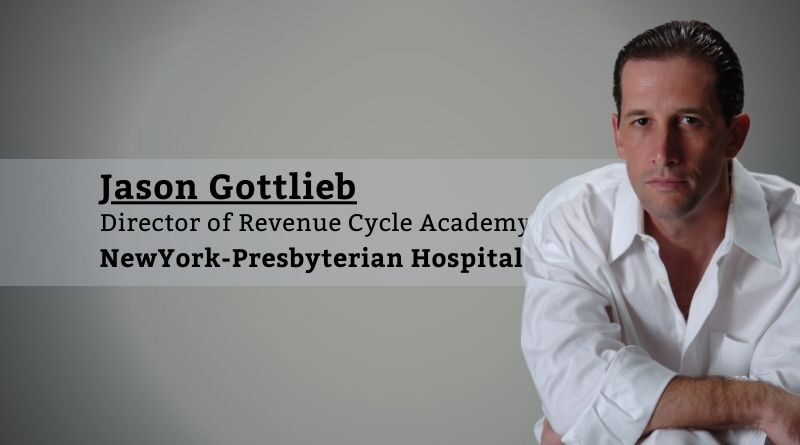A Beautiful MINED: An Intelligence Leveraged Roadmap for Next-Gen Revenue Cycle
By Jason Gottlieb, Director of Revenue Cycle Academy, NewYork-Presbyterian Hospital
There can be 200 or more individual pieces of data submitted on every hospital claim. A small hospital will submit a few thousand claims per week. Over a year, more than 31 million pieces of data contributing to revenue determinations. Payments. Denials. Requests… for even more data. Patient demographics, financial, and clinical encounter breadcrumbs telling the story of a patient’s journey through a complex healthcare system.
Yet today, we still have a relatively simplified view of which data elements – or combinations of those elements contribute to the likelihood of payment – or denial. Our business practices, workloads, and workflows are still rooted in what we believe to be the most obvious risk triggers. Without insight, who’s to say that the $100k claim should not be prioritized over the $10K claim? Or that the patient’s diagnosis, DRG, or CPT code is any more or less a predictor of payment than the patient’s last name. Data, and more importantly, intelligence that associates and connects that data to outcomes, can transform the revenue cycle and with any hope, the entire healthcare payment system.
A next-gen revenue cycle is distinguished from its current generation sibling in several ways.
- Liquidates 95% of expected revenue in 90 days
- Costs less than $.02 to collect
- Evolves the roles of the revenue cycle workforce
- Moves increasingly closer to the delivery of care
- Creates a seamless patient financial experience
This embodies the vision of revenue cycle as a claims-out/cash-in infrastructure performed faster, cheaper, more accurately, and with less risk. However, instead of that infrastructure being a separate ecosystem of back-end processes intended to subsidize deficiencies in upstream operations, a next-gen revenue cycle becomes a natural byproduct of the basic good and service that we as healthcare providers deliver – high-quality patient care.
As the revenue cycle and technology industries continue to partner on developing value-added intelligent automation use cases, the revenue cycle workforce will move further away from the mechanical activities that have historically defined the roles.
Intelligent technologies can support the goals of next-gen revenue cycle. Applications of these technologies have yet to produce the level of transformation desired. Rather, we’ve seen the latest version of incrementalism through the 21st century’s version of bolt-on solutions. Even in cases where solutions provide compelling value propositions, failure to evolve the non-technology aspects of the operation; its management and ownership structures, operating procedures, and workforce allocation models compromise benefit. While the gratification of an incrementalism approach to automation is alluring, revenue cycle transformation will remain elusive. Focus on these tenets as you begin laying out the roadmap to your automation journey.
Automate for outcomes over activities. The market landscape of next-gen revenue cycle solutions has been focused on opportunities defined as labor-intensive, repetitive, and clerical. Today’s most prevalent example is claim status automation. While nobody would deny that this fits the definition, it’s fair to question the value of claim status automation towards an outcome. Entities that have invested in developing 276/277 HIPAA workflows may see little value in such automation. At its root, claim status is just another form of rejection. And what rejection needs is a response; a corrective action that expedites that successful revenue cycle outcome.
Define end-to-end intelligently automated use cases. Intelligently automated use cases are designed to accomplish two things: automate upstream interventions that prevent adverse outcomes and automate the effective management of any adverse outcomes despite those prevention efforts. Prior authorization is another use case permeating the revenue cycle automation landscape. A transformative authorization use case is one that:
- determines authorization requirements;
- extracts salient clinical information from the patient’s record;
- creates and submits an authorization request;
- monitors the status of that request;
- reconciles the scheduled, authorized, delivered, documented, coded, billed, and paid service and escalates deficiencies and risks to appropriate resources;
- performs corrective action on authorization denials;
- creates analytics and measurement on operational efficiency, quality of work product, and outcomes; and
- creates a value proposition based on those outcomes.
A use case designed with a deep understanding of the contiguous effort of a function’s contribution to the completeness, efficiency, and quality of an outcome has a broader transformation appeal.
Implement solutions that redefine legacy revenue cycle business practices. We can’t just automate existing revenue cycle processes. Transformative intelligent automation identifies non-value added effort toward revenue cycle outcomes and eliminates, re-sequences or enhances the function within the larger business process. Let’s jump back to claims status. Understand that claims status (as a business office activity and a HIPAA transaction) was borne out of an archaic and volatile claims submission environment where the odds of your submitted claim being “on file” with the payer were about the same as being swept up in your favorite catastrophic weather event. This exercise in audit trail security is no longer the case. The small handful of claims that do fail to materialize with the payer can rely on other use cases to increase the likelihood that claims are being sent with the right information to the right third party all the time.
And those 31 million pieces of data? They can identify cohorts of risk in your receivables that are not otherwise evident in your average pivot table. These cohorts become the basis of intelligent workload assignment and collection priorities. A third-party propensity to pay score prior to claim submission accelerates the AR management activity and converts it into a revenue assurance activity.
Make validation and audit the new entry-level for revenue cycle personnel. As the revenue cycle and technology industries continue to partner on developing value-added intelligent automation use cases, the revenue cycle workforce will move further away from the mechanical activities that have historically defined the roles. The next-gen revenue cycle professional is a compliance expert, a quality specialist, and a process engineer. The role is one of perpetual review and refinement. Identifying the new – and smaller universe of exceptions to intelligent and learned processes and working with solution experts to build a path to further inclusion.
Don’t automate, optimize. The shiny bright hue of RPA, AI and the like understate that the revenue cycle is predominantly automated. According to research, 7 in 10 claims can generate payment without ever being touched. Before automating, ensure your host RCM platform and your processes are fully enabled and support your efforts to drive timely, accurate payment.
Next-Gen Revenue Cycle Partners
Your next-gen revenue cycle may require engagement with one or more automation partners to address opportunities your current generation revenue cycle presents. There is much interest in this sector and it can be hard to distinguish the mission and vision-oriented players from the venture-capital funded serial entrepreneurs looking to boost market value and sell to the highest bidder. A thoughtful exercise in evaluating these partners is crucial. Some key decision-making criteria include:
- demonstrated success at peer facilities, nationally and locally;
- value-added application of next-gen technologies – RPA doesn’t work on its own and robust rules engines are not next-gen;
- a defined implementation methodology that considers technological and non-technological aspects of the product/service;
- integration with your host RCM and/or EHR platform; and
- a robust analytics strategy and application to demonstrate operating performance and value of the investment.
Revenue Cycle 2050?
Ideally, our healthcare industry evolves into a goal-aligned point-of-sale payment system. Efforts to share real-time data between payer and provider are setting the stage for this evolution in the regulatory environment and private industry. These include the No Surprises Act and Epic’s Payer Platform. Lastly, re-defining the HIPAA transaction sets as not a linear set of data transactions but a concurrent ecosystem of blockchain-supported patient/subscriber, contractual, and clinical information exchange will provide both the protections and transparency necessary for real-time adjudication.



